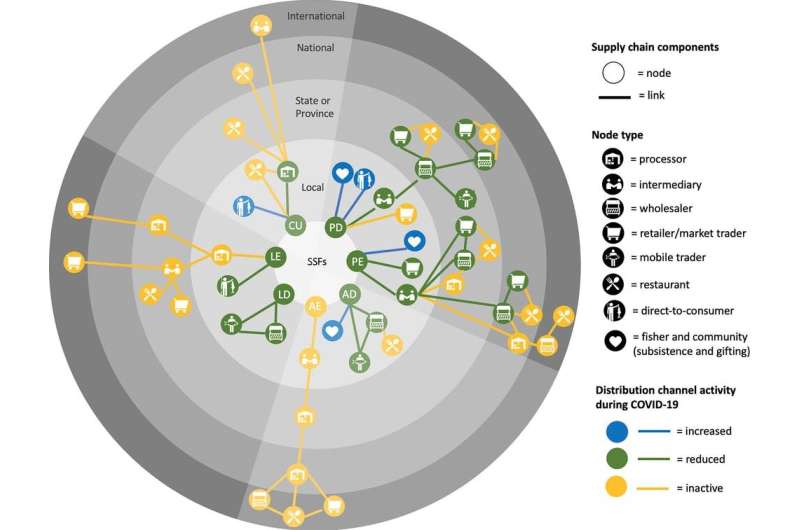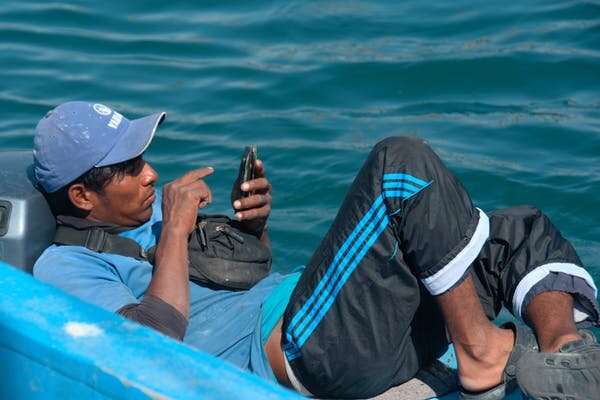How small-scale seafood supply chains adapt to COVID-19 disruptions

In February 2020, Rio (not his real name), a crab and sea snail processor in Langkat regency on the Indonesian island of Sumatra, found his business drying up. Normally at this time of year his business would have been booming from seafood exports to China and Hong Kong for the Lunar New Year festival.
Like many others in small-scale seafood supply chains across the world, Rio was feeling the impacts of COVID-19.
In the early months of the pandemic, community lockdowns and public health risks combined with restrictions on worker movement and seafood trade forced small-scale fishing communities in several parts of the world to close down their businesses. They were left in a state of economic and social uncertainty.
Some small, local seafood vendors, like Indonesian pedagang along-along who sell fish, vegetables and other perishable foods from motorbikes, adapted. They were able to continue selling seafood despite the pandemic.
How did they cope? What helped or hindered others in small-scale seafood supply chains as they dealt with uncertainties generated by COVID-19?
In a recent article, we documented the initial pandemic impacts and responses across seven seafood supply chains in Indonesia, India, Peru and the US. Our findings offer insights into how to increase the adaptability of fishworkers and small-scale seafood supply chains in preparation for future shocks.
Coping amid the pandemic
In some countries, like India and Peru, the important role of fishing and seafood sales in maintaining livelihoods and providing food was overlooked. The sector was not classified as an essential service and was not allowed to continue operating, despite its economic contribution to society.
Seafood is the most traded food item in the world. Yet an estimated 81% of the catch from small-scale fisheries is sold for local consumption.
The global small-scale seafood sector employs 32 million fishers and 78 million individuals involved in processing and sales. Seafood supply chains are economically important for trade and livelihoods and critical to food systems.

International trade supports the livelihoods of many fishworkers, but also exposes them to the risks of global markets.
As COVID-19 began to disrupt international trade, fishworkers involved in seafood exports had few options but to sell locally. Due to differences in preferences, this was not always successful. For example, jumbo flying squid is eaten in Peru, but not at the volumes or in the product forms consumed in the international market.
In some cases, high-production areas such as Langkat or coastal regions of Peru ended up with more seafood than local markets could handle. The result was a price crash.
Participating in a variety of supply chains, particularly at smaller, more local scales, helped some fishworkers deal with these shocks.
For example, in California, consumption of sea urchin roe, or uni, was usually limited to restaurants. With restaurants closed, some uni fishers and sellers promoted local supply chains by teaching customers how to handle and prepare uni at home. This made direct sales easier.
In India's Andaman Islands, grouper fishers switched from multi-hooked longlines to nets. This enabled them to catch different fish and sell these to local markets.
Similarly, Peruvian offshore and high seas artisanal fishers switched to nearshore fishing. By doing this, they contributed to local food security while earning revenue from diverse sources.
In all seven of the seafood supply chains we examined, some individuals and organizations quickly changed their marketing strategies and adapted to pandemic-related regulations.
Existing networks of fishery organizations and relationships with consumers helped reorient supply chains. For example, Peruvian fishing associations, which are normally socially and politically active, began marketing seafood through local supply chains.
In India, the Dakshin Foundation and other non-profits working along the coast harnessed existing networks like the National Fishworkers Forum and partnered with boat associations in several coastal states, including the Andamans, to distribute food aid within fishing communities and help stranded fishworkers return home.

With limited ability to meet in person, fishers and seafood traders used familiar apps, like WhatsApp, to communicate with other fishworkers and connect to local buyers.
In the Andamans, communities used WhatsApp to co-ordinate aid. In Peru, it was used to set up informal fish distribution networks. This enabled fish sellers to launch new services such as door-to-door delivery.
California's Tuna Harbor Dockside Market quickly developed an online platform to sell directly to consumers. At the same time, this increased their social media presence. The shift to online marketplaces enabled some fish sellers to reach a wider audience.
What's next?
COVID-19 has exposed many existing weaknesses in small-scale seafood supply chains. It has also highlighted several successful strategies for adapting to such large-scale shocks.
In the cases examined, these actions contributed to livelihoods and seafood distribution being able to continue during this pandemic.
The successes and failures of strategies adopted by individuals and organizations within this sector offer clear lessons for policymakers, the public and development agencies.
Policymakers could recognize small-scale fisheries as essential food suppliers, while local markets support small businesses and fishing communities to help supply chains adapt to disruptions.
When it comes to technology, NGOs, development agencies and the tech sector could help cultivate social networks and digital technologies for that purpose.
These lessons can inform adaptations to climate change and other predicted threats to seafood supply chains in Indonesia and beyond.
Provided by The Conversation
This article is republished from The Conversation under a Creative Commons license. Read the original article.![]()




















